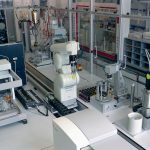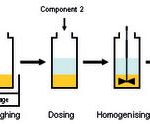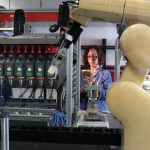High throughputs, optimum reproducibility and maximum flexibility – these were the requirements specified by BASF’s research laboratories for two modern robot systems to prepare and characterize emulsions and suspensions. The development and construction parts of the project were entrusted to the company’s Technology Centre Automation (Fachzentrum Automatisierungstechnik). Not only does BASF possess the expertise vital to develop robot systems for laboratory automation, its specialist services are also offered to external customers.
BASF’s Performance Products operating division frequently receives enquiries from customers asking, for example, which emulsifier in its product range is best suited for their particular formulations. Questions like these no longer create any serious problems for the department. In a very short time, a multitude of emulsifiers can be tested by its two laboratory systems. Each system is 6 m long, 2.20 m wide and 2.40 m high. At their heart is a robot that supplies samples to 20 different workstations.
Finding the optimum formula
Formulations like emulsions and suspensions have a wide range of applications in the chemical industry. They are common, amongst other things, in creams, pesticides and paints. Several BASF operating divisions, such as manufacturers of fine chemicals, agricultural products or performance chemicals and functional polymers, therefore take advantage of the broad array of services offered by the two robot systems in support of product development: when it comes to dosing low-viscosity liquids, powders or wax melts, for example for special dispersions of the kind essential for papermaking, their precision is unbeatable.
Dr. Günter Oetter of BASF’s Competence Centre Formulation Technology (Kompetenzzentrum Formulierungstechnologie): “The requirements specified for formulations have increased significantly in the last few years and the number of necessary tests has risen accordingly. What’s more, product development times are getting steadily shorter and the tests have to be completed faster.” Bottlenecks on the application side were consequently unavoidable. The operating divisions often need to know whether or not the different constituents of a suspension or emulsion are compatible. The lab frequently has to pinpoint the optimum emulsifier or the optimum combination of two or more emulsifiers. An average of a hundred samples are prepared and characterized every day in each of the systems. However, the number of samples per day is only one criterion along with their reproducibility and scalability. Furthermore, a sufficient quantity of samples must be prepared, to enable the best to be selected for preliminary application tests outside the robot system.
One question – over a thousand samples
As well as banishing the bottlenecks, the two robot systems have also opened up several new possibilities. It sometimes happens that more than a thousand samples have to be prepared in order to answer a single question. Many effects and formulations can only be identified if a sufficient number of variations exists. Finally, there are quite simply many more opportunities available, as Dr. Stephan Hess, also of the Competence Centre Formulation Technology, confirms: “If we are requested to determine a suitable emulsifier system for a particular oil, we can test an absolutely huge breadth.“ The high throughput values are not achieved at the expense of imprecisely dosed or analysed samples, however. “When all is said and done, we can vary the diverse parameters – such as the type and concentration of the emulsifier, the oil-to-water ratio or the energy input during the homogenisation process – to obtain optimum application properties”, Hess adds in conclusion.
Although the questions the Centre is being asked to solve differ enormously, one requirement that applies equally to all tests: “Regardless of the formulations involved, our lab tests usually bring the greatest benefit if they are carried out close to the process and are consequently suitable for scaling up. We therefore prepare our samples under conditions that are as similar as possible to those prevailing in the production plant, such as a stirring vat.“
Flexible test procedures
The path taken by each sample is freely definable in the two BASF systems. The lab staff can configure the formulation and characterization steps simply by dragging and dropping in the scheduler software. No special programming knowledge is required. The systems are thus suitable for a wide variety of tasks. The modules are combinable in any way. A test can be started in one system, for instance, and then continued in the other. The complete test schedule is also documented electronically and the test procedures are clearly displayed on the monitor in the form of flow charts.
All important data bar coded
Sample preparation typically comprises the following steps: first, a bar code containing detailed information about the sample (formulation procedure and constituents as well as analysis methods) is affixed. All data, including the measurement results and the test procedures, is available in the database of each system. The barcoded sample is then supplied to the first dosing station. The actual preparation phase begins here with the addition of an active ingredient dissolved in organic solvent. At the next station – a pipetting station – small quantities of two emulsifiers are added individually. Finally, water dosed by a peristaltic pump is added at the third station. Each workstation is equipped with a balance that measures even tiny quantities of the added substance precisely down to a few milligrammes. The next step is homogenisation. Once again, both systems offer the same functionality – from simple shaking or stirring of the dispersion with an Ultraturrax to ultrasonic dispersion, where very high energy inputs can occur. Homogenisation can also take place at high temperatures. Oetter explains: “This means we can prepare samples with different temperature profiles, just like in the real production process. Components can be added as the sample is heated or cooled.“ The next station is equally finely tuned. Powder can be added in quantities of a few milligrammes without risking any carry-over.
Sample analysis
The most important result when a dispersed system such as an emulsion or a suspension is analysed is usually the particle or droplet size. The two systems are capable of providing information about any distribution from millimetres to nanometres. Viscosity, homogeneity and phase and flow characteristics are further key parameters. Each step and each dose or measurement is stored in a central database. The numerous statistical evaluations facilitated by this information support the measurement results and help shed light on complex interdependencies. It is possible to determine the time history of tests, for example, and compare different test series (data mining).
cpp 411
BASF-Homepage
Laboratory automation
Association for Laboratory Automation
Share:









